9–10 September | Barbican Centre


9–10 September | Barbican Centre















1,000 in-person delegates 580 Designers
81 countries in-person and online from across the world


The biggest challenge of our era is the climate crisis. And design has a critical role to play given that 80% of a product’s environmental impact is determined at the design stage. We need to redesign nearly every aspect of how we live our lives.
As the Design Council’s core mission, and with growing climate urgency, Design for Planet was the clear choice for the theme of the World Design Congress 2025.
The effects of climate change have created global problems, therefore, we need global solutions. Being able to convene change makers from around the world, across business, government, education and design gave us an unprecedented opportunity to gather, share, learn and spark vital creativity needed to drive action.
We explored the theme through five key lenses:
Hope isn’t just an aspiration, it’s a strategy. Pioneering ideas are already in action, and making a difference. They’re demonstrating that by interconnecting efforts across global borders, sectors and disciplines, we can tackle the Earth’s shared challenges.
Waste is a design flaw. But it can be transformed into a valuable resource, adopting practices of reuse, repair, and repurposing as the new norm. Real-world examples show us how aligning economic incentives, supportive policies and industry partnerships can revolutionise practices and reshape industries.
The need to decarbonise at scale is critical. From transport to energy systems, there are cuttingedge examples of how design is turning low-carbon technologies into widespread solutions, advancing netzero emissions equitably through innovation, upskilling and policy collaboration.
We are at a pivotal moment where design must transcend sustainability. We need to design regenerative places that are in harmony with nature, integrating biomimicry and systems thinking, and collaborating with communities as stewards.
What are we all going to do to ensure these transformative ideas become reality? Explore what’s needed to make it possible, including skills, collaboration, policy, finance, hope and determination. Together, we can design the path forward.















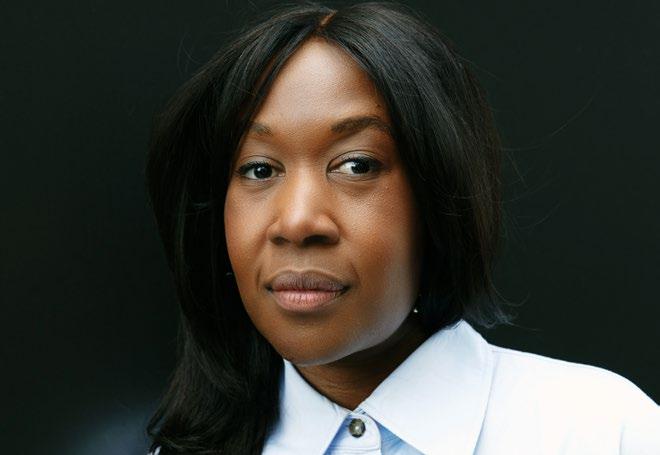



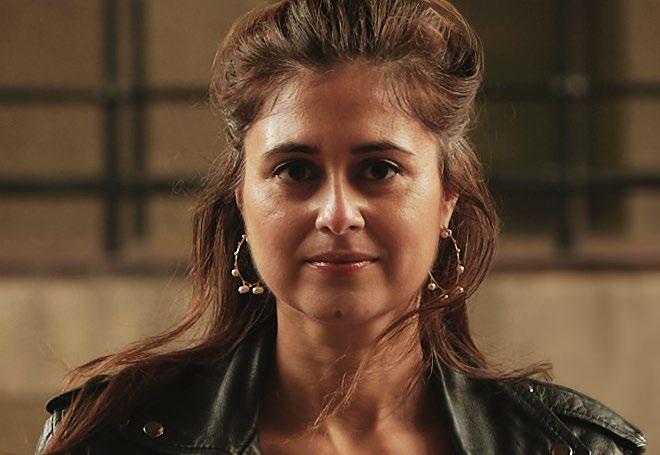







In the lead-up to the Congress, we built global awareness and excitement for the event and Design for Planet mission.
We launched an international campaign led by five visionary Ambassadors:
Es Devlin Artist and Stage Designer
Tom Dixon Industrial Designer
Professor Lesley Lokko OBE w Academic and Writer
Foday Dumbuya Fashion Designer
Suhair Khan Creative and Technology Leader
Together, they selected 20 Design for Planet Trailblazers from around the globe. Collectively, these ‘25 for 2025’ embody the creative force driving sustainable transformation across design disciplines.
From fashion to AI, materials to the built environment, the campaign shone a light on those championing narrative-driven design, next-generation materials, new educational models, and the democratisation of creativity through technology.
Coverage from outlets such as the Financial Times (which hailed the Congress as “the Olympics of design”), The Guardian and The Observer amplified the global reach and significance of this mission.
Each of the 25 for 2025 used their voices and platforms to build noise and credibility for the Congress that drove media interest, partnership opportunities and ticket sales.

During Clerkenwell Design Week 2025, we sponsored a roaming film truck to advertise the Congress to the London design audience. It garnered more than 12,000 views over the course of two days.


The Barbican Centre is recognised worldwide by design enthusiasts as an architectural treasure.
It was the clear frontrunner from our shortlisted venues thanks to its unique design history, central London location, capacity to host a more ambitious number of delegates, room setup and strong environmental commitments. The main auditorium gave an impressive backdrop for the lead programming and their iconic Conservatory garden provided a truly memorable space for the evening reception and partner moments.
of Most Sustainable Venue (2019 and 2021), Barbican Centre is committed to reducing carbon emissions from operations in waste, energy, water, biodiversity, food & drink and in their shop. We worked with their catering provider, Searcy’s, to craft a meat-free menu that used local ingredients, limited food waste, processed waste into biofuels and prompted sustainable choices such as oat milks.
Supported by consultancy from the Design Council, Barbican Centre is currently undergoing a renewal project to upgrade the building in inclusivity, sustainability and resilience.
Working with a dedicated sustainability consultant through our production partners at Stitch, we aimed to uphold the highest environmental, social and governance standards at every level when designing the Congress, placing the Design for Planet theme at the event’s heart.
Venue & Production
Selected for strong environmental credentials, with responsible suppliers for staging, furniture, catering and all materials.
Partners & Content
Collaboration and partnerships only with organisations and speakers aligned with sustainable values and inclusive practices.
A carbon calculator integrated into registration encouraged more sustainable travel choices, supported by regular communications promoting low-impact travel and ESG-reviewed accommodation recommendations.
A scaled-back approach to physical printing, using digital formats or volunteers to signpost where possible and recycled paper and sustainable options where required.
Encouraging delegates to maximise their international travel through a calendar of design events in London.
Our event carbon cost totalled 5,176.0566kg (5 tons).
The average event of this side totals an average of 17 tons so we were delighted to be well under this.
Our collaboration with Stripe permanently removed 13 tons of carbon dioxide. This was done by donating £3,575 to eight of their climate action funds. All of these funds were used to purchase permanent carbon removal from promising early-stage technologies.


Studio OPX created a bold, dynamic and colourful aesthetic.
This was developed around the existing Congress logo (designed internally as an evolution to the Design Council’s Design for planet branding). They developed a versatile brand toolkit for digital assets, with a wide range of dynamic colours, shapes and animations to engage online audiences, and physical dressing and wayfinding formats to bring the Barbican Centre to life.








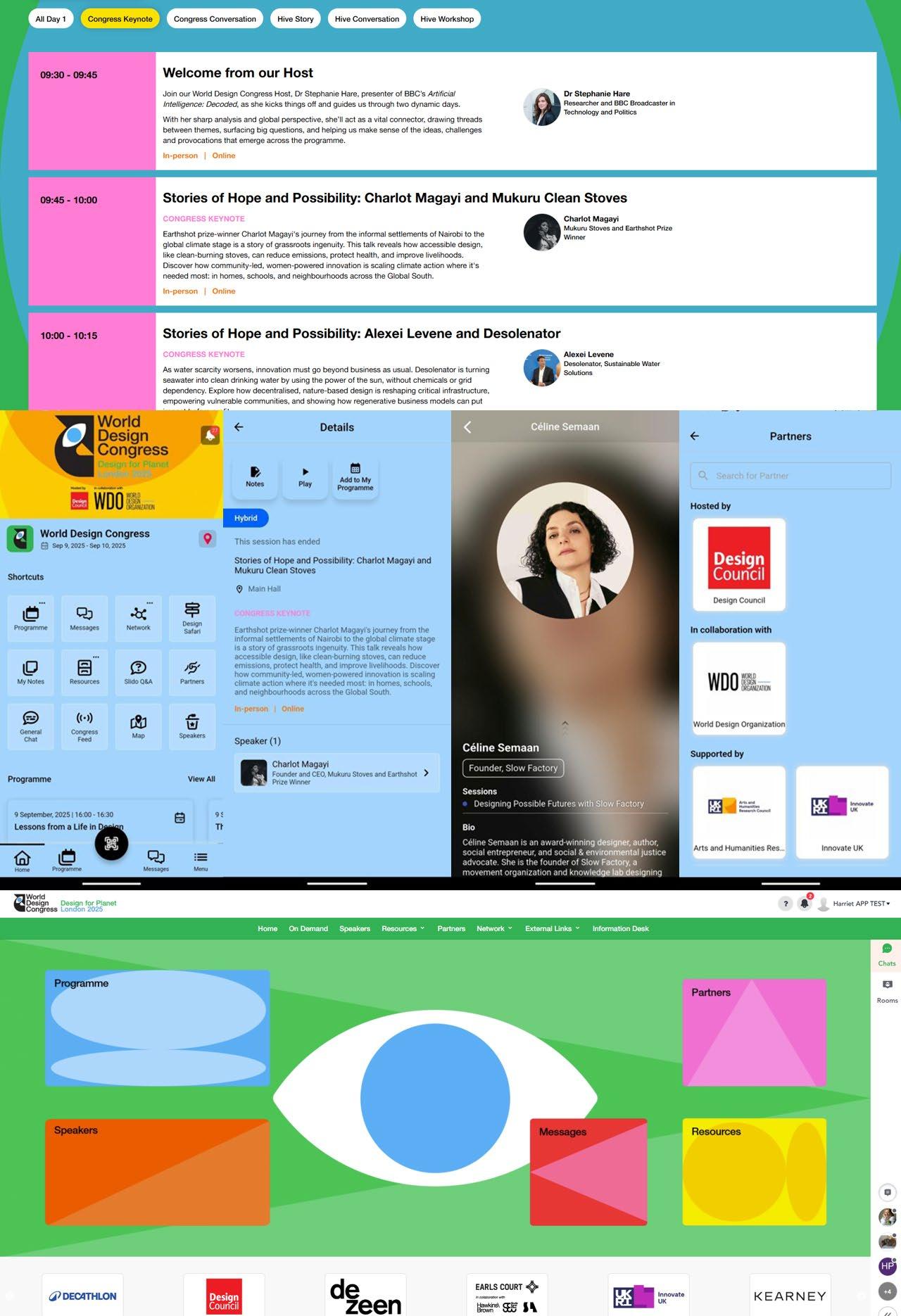
We formed a strong digital presence through our website, digital platform, and custom app.
From the start of their Congress journey delegates were presented with a cohesive and unified journey through the visual identity. This gave them a strong sense of familiarity and belonging when they entered into the physical space at the Barbican Centre.
The decision was made, during the planning stages, to create a digital only Event Companion rather than printing delegate programmes. It was designed to give a more in-depth look into the Design for Planet theme and allowed key partners to offer thought pieces and showcase their work.
We utilised our visual identity across the Barbican Centre both through physical, digital and people branded elements.
To help delegates smoothly navigate the Barbican Centre, staff wore t-shirts with a simple yellow circle design to instantly stand out and offer help with any questions on the day.
The visual identity, with its triangle shapes, allowed us to create playful wayfinding signage, signalling Congress areas and pointing towards the correct direction.
A single-sheet fold-out map was created to further aid navigation and ensure any accessibility needs were provided for those not using the app. It included the programming locations and key amenities.
The reverse side displayed a keepsake poster, created by Liberty London in honour of the Congress, to offer a second life for the print assets.



The programme structure was curated to drive behaviour change and prepare the audience for action.
We curated content that would lead the designers, businesses, researchers & educators and policymakers in the room to leave feeling:
Inspired Big visionary talks showed the scale of possibility.
Connected
Networking, formal and informal, was designed to connect delegates across disciplines, geographies, and generations.
Knowledgeable
Practical workshops and case studies provided tangible tools.
We redefined the two day structure to embed the research and education thread throughout, showing the importance of design to turn research into action, and the skills and knowledge to spread this further.
The narrative arc across the two days aimed to show action being taken, showing there is possibility, particularly when people act together.
We broke Design for Planet down into three themes: circularity, reducing emissions and biodiversity, with the first two on day 1 and last on day 2.
Day 1 focused on stories of individual inspiring designers, whereas Day 2 turned to what we need to do together as a sector.
There were 7 key messages that provided overall coherence, which included stories of hope and possibility, the need for collaboration (with communities, nature and AI), the importance of systemic design and redesigning business models etc.
The main stage hosted well-established designers including Norman Foster and Thomas Heatherwick, alongside celebrity names like Brian Eno and upcoming designers with incredible stories like Charlot Magayi and Priya Ahluwalia.
To create a catalytic moment, the structure of the Congress had to balance visionary keynotes, practical deep dives, and participatory formats.
Keynotes
Anchoring the big picture and providing inspiration from some of the world’s most influential design and policy thinkers.
20 Panels
Multidisciplinary debates that framed systemic issues from business, government, and practice.
Real-world projects unpacked in detail, bridging research to application.
Four Workshops and Experiences
Participatory spaces where delegates gained tools and methods they could use immediately.
Eight Exclusive Film Previews
New cultural content adding depth and narrative power.
Three Installations, Six Activations and Three Exhibitions
Ensuring the Barbican itself became part of the design conversation.
A key challenge was how to orchestrate up to 1,200 delegates across the Barbican’s many levels and spaces. The programme was designed with deliberate pacing:
Main Stage
These moments created energy and focus points where the full Congress came together.
Hive Sessions
Across the Barbican Centre these sessions offered more intimate spaces for panels, unconferences, and case studies.
Exhibitions and Activations
These provided continuous engagement in transitional and social spaces, softening the edges of movement between rooms and giving people a chance to meet and connect in different settings and scales.
177 Speakers
33
10
Stories from the future.

Individual designers and how they have pioneered new practices or skills.
Learning from the past to see the future. What different sectors or collaborations need to do to change practices.
Use less – Net zero and circular. Design is about business models as well as products and services.
Grow more – Biodiversity. Nature is a beneficiary and a co-designer.
Collaboration with others: Business and Policy.

Collaboration with others: Communities, AI, Nature and Policy.
Welcome from our Host 09:30–09:45 (15 mins)
Stories of Hope & Possibility
Congress Keynote | 3 x 15 mins & 1 x 7 mins 09:45–10:40 (55 mins)
Presentation of WDO World Design Medal 2025 to Dieter Rams 10:45–11:00 (15 mins)
Break
11:00–11:30 (30 mins)
Designing the Economy We Need: Missions, Doughnuts, and Radical Collaboration Congress Conversation 11:30–12:00 (30 mins)
From Small to Large – Scaling Sustainable Solutions
Congress Keynote 12:00–12:30 (30 mins)
Lunch
12:30–14:00 (90 mins)
HIVE PROGRAMME across the Barbican 14:00–15:30 (90 mins)
Break
15:30–16:00 (30 mins)
Less from a Life in Design with Norman Foster
Congress Keynote 16:00–16:30 (30 mins)
Threads of Change: Fashion Future Rooted in Justice
Congress Keynote 16:30–16:45 (15 mins)
The Legacy We Leave Congress Conversation 16:45–17:15 (30 mins)
Building More with Less: Sustainable Digital Concrete with Zaha Hadid Architects
14:00–14:30 (30 mins)
Three Horizons, One Mission: Decathlon’s Track to Sustainable Sport
14:30–15:00 (30 mins)
Agency by Design: Youth, Solar & Opportunity in Kenya
15:00–15:30 (30 mins)
Design for Planet in Action: Fabrication, Futures, and Frontlines
Auditorium 1
220 pax
Main Hall
495 pax
Design for Planet in Action: Systems, Surfaces, and Shifts
Aqua Culture: Regeneration Below the Surface 14:00–14:30 (30 mins)
The Power of Design for Business Transformation with Panasonic 14:30–15:00 (30 mins)
Going Beyond 15:00–15:30 (30 mins)
Auditorium 2 150 pax
Skills for Planet
14:00–15:30 (90 mins)
Future Forward: Designing for a Zero-Emission World 14:00–14:45 (45 mins)
Supply and Demand: Shaping the Market for Green Design Skills 14:45–15:30 (45 mins)
STREAMED ONLINE
Main Hall, Auditorium 1 & 2
From Lab to Market: How Design Turns Research to Commercial Opportunities 14:00–15:30 (90 mins)
Frobisher 1 60 pax
The Business Case for Circular Innovation
Equipping Designers for a Regenerative World
Fountain Room
80 pax
Frobisher 2
120 pax
Conservatory Terrace
75 pax
Garden Room
75 pax
Mind the Gap: What’s Holding Business Back from Circular Design?
14:00–14:45 (45 mins)
Design in Green Demand with Innovate UK 14:45–15:30 (45 mins)
Waste Not, Want Not: From Waste to Wonder 14:30–15:00 (90 mins)
From Lab to Market: How Design Turns Research to Commercial Opportunities 14:30–15:00 (90 mins)
Kicking off the sustainable design event of the year.
Day 1 opened with an emotive performance from London based children’s choir We are the Voice followed by a special recorded address from Dr. Jane Goodall.
Throughout the day we heard stories of hope from Charlot Magayi, Mariana Mazzuccato and Kate Raworth.
The afternoon saw breakouts involving companies including Panasonic, Zaha Hadid Architects, Innovate UK and Decathlon.
The afternoon closed with a keynote from Priya Ahluwalia and conversations between Dezeen’s Max Fraser, joined by Tori Tsui and Brian Eno.

Hosted at the unique Barbican Conservatory.
The first day culminated in a VIP Evening Reception for WDO members, sponsors, speakers, media and ticketed guests.
Held in the Barbican Centre’s unique conservatory, food and drinks were served with music and bespoke lighting for 600 guests.


Welcome from our Host 09:30–09:45 (15 mins)
Global Greenprints
Congress Keynote | 4 x 15 mins 09:45–10:45 (60 mins)
Research to Real Impact with AHRC with Professor Christopher Smith 10:50–10:55 (5 mins)
Break 10:55–11:40 (45 mins)
Design for Good: Collaborating for Lasting Impact Congress Discussion 11:40–12:20 (40 mins)
Designing the Age of Stewardship Congress Keynote 12:20–12:40 (40 mins)
Lunch 12:40–14:00 (80 mins)
HIVE PROGRAMME across the Barbican 14:00–15:30 (90 mins)
Break
15:30–16:00 (30 mins)
Less from a Life in Design with Norman Foster Congress Keynote 16:00–16:30 (30 mins)
Threads of Change: Fashion Future Rooted in Justice Congress Keynote 16:30–16:45 (15 mins)
The Legacy We Leave Congress Conversation 16:45–17:15 (30 mins)
Cultivating Community Champions: A Global Skills Revolution 14:00–14:45 (45 mins)
Sustainable Intelligence: Designing Ethical and Green AI 14:45–15:30 (45 mins)
Communities, AI and, Collective Impact
Cinema 1 260 pax
Main Hall 495 pax
Building for the Future
Nature’s Inspiration x Human Creativity
14:00–14:45 (45 mins)
Nature as a Designer: When Nature is on the Team
14:45–15:30 (45 mins)
Powering Resilient Ecosystems: Where Energy, Biodiversity and Innovation Meet 14:00–14:45 (45 mins)
Designing with Nature Auditorium 2 140 pax
Thriving Cities: Designing for Future Prosperity 14:45–15:30 (45 mins) Auditorium 1 220 pax Green is the New Growth
The Irresistible Future: Designing Desire for a Greener World 14:00–14:45 (45 mins)
From Profit to Purpose: Re-designing Business Models with Magnetic 14:45–15:30 (45 mins)
STREAMED ONLINE
Main Hall, Cinema, Auditorium 1
Ideas to Action: Workshop with Design Declares! 14:00–15:30 (90 mins)
Design Entanglement: Join the Royal Designers to Reconnect with Nature 14:00–15:30 (90 mins)
Frobisher 2 120 pax
Fountain Room 60 pax
Conservatory Terrace 40 pax
Garden Room 50 pax
New Pathways for Societal Prosperity: Book Launch 14:30–15:00 (90 mins)
Designing Possible Futures with Slow Factory 14:30–15:00 (90 mins)
Closing the Congress with the new Minister, and iconic designers.
Day 2 began with inspiring stories from Leyla Acaroglu, Thomas Heatherwick, and Professor Christopher Smith, with a keynote from Indy Johar before lunch.
The afternoon breakouts brought together delegates and leading designers’ organisations including, Slow Factory, Design Declares! and Magnetic, as well as a unique opportunity to engage with RDIs.
The day concluded with Lord Deben, Nick Foster and new Minister for Culture, Media and Sport, The Rt Hon Ian Murray MP.



The Design Council hosted a breakfast and tour of the event for Arts and Humanities Research Council (AHRC) officials and a delegation from Canada, as well as welcoming the Mayor of Busan and delegation to present the World Design Capital 2028.


A valued part of each World Design
Congress is the public call for papers and posters.
Submissions for abstracts were open between January and May 2025 under the overarching theme of Design for Planet and the following subthemes:
Shifting Paradigms — From Extractive to Regenerative Design
Design is moving beyond sustainability toward approaches that restore and renew ecosystems. This sub-theme explores regenerative frameworks including systems thinking, circularity, and biomimicry.
Economy and Design — Innovating for Circular Economies
Design plays a critical role in transitioning from linear economic models to circular systems that emphasize reuse, repair, and material longevity. This sub-theme examines how design innovation supports and prioritised this shift.
Policy and Design — Shaping a Global Response
From climate adaptation to urban resilience, this subtheme considers how design informs and is informed by policy frameworks shaping environmental futures.
The presentation of these papers and posters was made semi-open within the Barbican Centre venue so that the public could engage with some of the papers and posters as well as delegates to the Congress.

We partnered with a range of organisations across business and government.
They supported this once in a generation opportunity to showcase the best of UK design and innovation, and leadership in harnessing design to address the climate and nature crisis.
Partners were present across the build-up campaign, programming and activations to bring their unique perspectives and amplify the Design for Planet message.
We designed a tiered system of partnerships to unlock different levels of support as Mission, Congress, Activation, Media or Ecosystem partners.











Across the event, we worked with our sponsors and partners to create opportunities for delegates to engage with innovative design examples.
This included installations from Kearney, Zaha Hadid Architects and World Design Capital Frankfurt 2026.
OZRUH Studios presented their 3D printed sand sculpture, Material Matters hosted their sustainable design bookshop, and Nook x Smile Plastic provided pods for delegates to meet and network in.
In our specially designed ‘Host Hub’, WDO and Design Council showcased their unique histories in collaboration with Brighton University archives.
In addition, we hosted exclusive breakfasts and lunches for press, AHRC, DBT and Earls Court Development Company across the two-days.







92m Social Reach
103k Web Visits
186k Newsletter Sends
4.5m
Reach from User Generated Content
25+ Ecosystem Partners










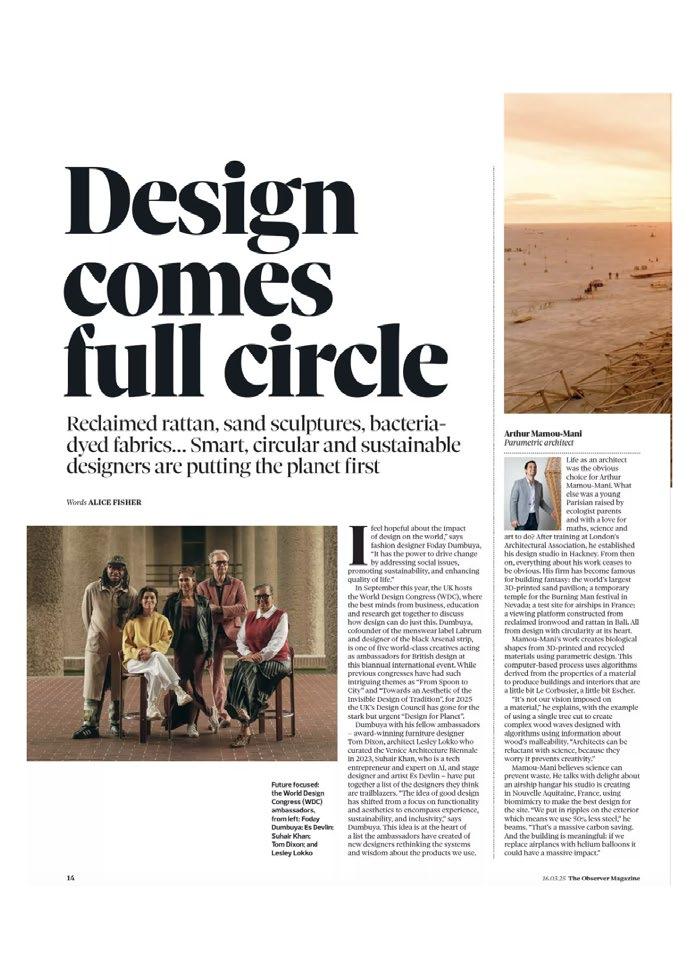










An in-depth survey of the event was sent to all delegates on 11 September. 51 NPS Score 75% Rated the Event +8/10
“I found many of the sessions to be really thoughtprovoking, timely and picked up some useful names / resources to bring into my work (education).”
“The only experience felt like we were in the room – it was a very informative and interesting event.”
“Impactful speakers. Intense two days witha huge expanse of content covered. Great that I can watch back.”
168 people responded to the survey representing 17% of the attendees.
71% gave a score of 7/10 or more to the question ‘To what extent do you feel you have learned something new?’ (18% gave 10/10).
78% gave a score of 7/10 or more to the question ‘To what extent do you feel ready to act (inspired, connected, knowledgeable)?’ (22% gave 10/10).
80% gave a score of 7/10 or more to the question ‘To what extent do you feel the speakers represented diverse perspectives and experiences?’
“I love that this year, the speakers were from different fields...I would love you to continue in this direction, rather than just focus strictly on industrial design.”
“All the content was excellent - a rare thing for conferences! There was a clear arc to where the content was taking us across the two days and all the speakers were clearly very well briefed and produced excellent content.”
“I loved the hive sessions...I find this kind of interactions very valuable! The energy of that session was great to connect with people and reflect in a meaningful way.”
“Enjoyed the range of speakers old masters with new innovators and thought the online provision was excellent for those that can’t afford the high costs of the tickets.”


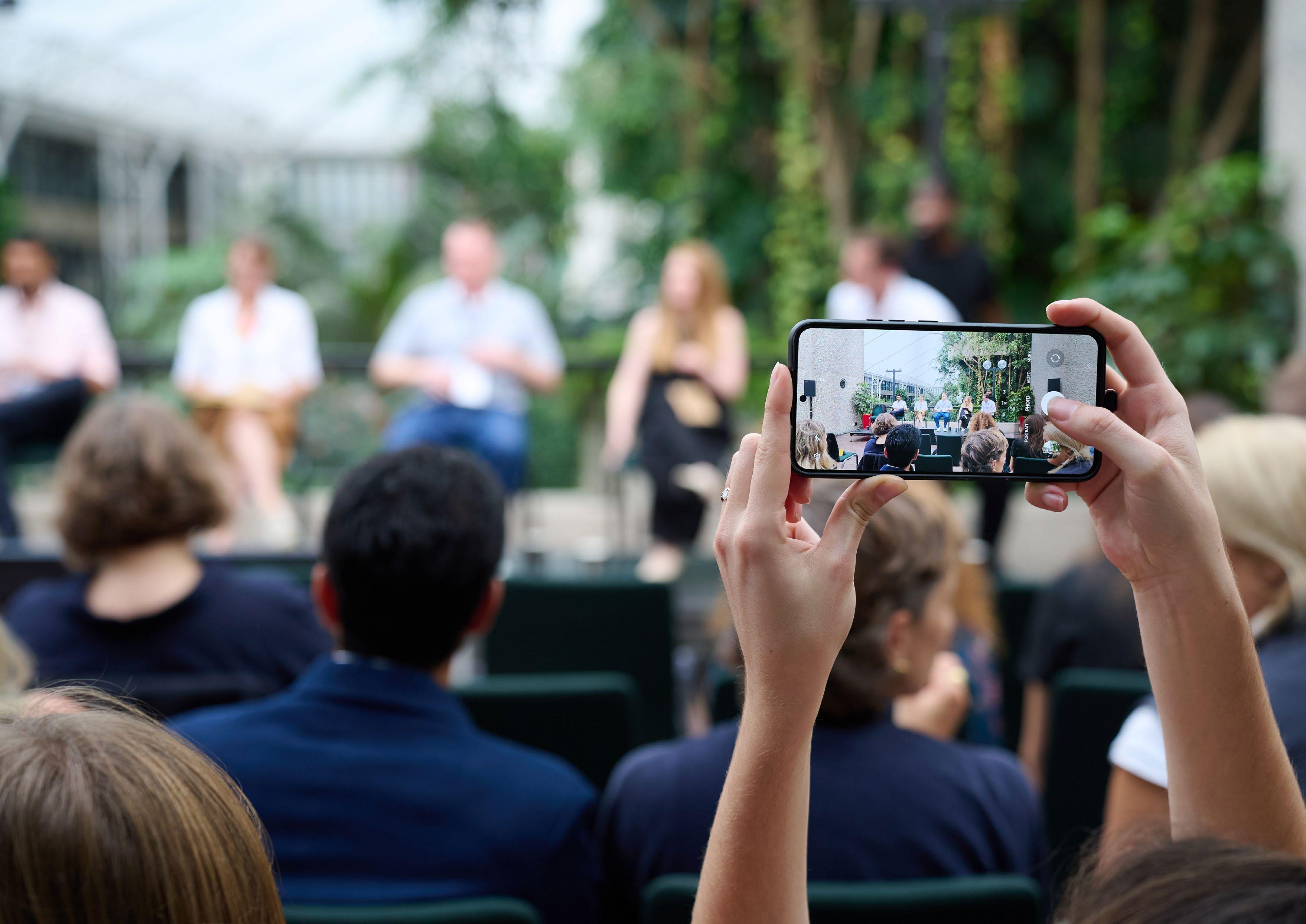

“Huge congratulations to you and your team for delivering what was clearly a landmark event.”
“It was wonderful for us to be part of shaping and supporting such a landmark moment for the global design community.”
“We’re proud of what we achieved together and look forward to building on this momentum and continuing to champion design for the planet.”
“What an honour it was to be invited. Thank you as well for giving me the space (and the tolerance!) to share my thoughts.”
“I think some really important things can come from this, and I just wanted to say how grateful I am for all that you’re doing.”
“I have been so inspired by your speakers and what a slick event. I have a million books to read now and have already started thinking of ways to do things differently. a world class event at an incredible venue, and was thrilled to see that even tube strikes were effortlessly managed by the team and overcome by the audience! learnt new ways of seeing the world through design truly inspirational.”
“Congratulations on a jam-packed World Design Congress! What a brilliant gathering of people, conversations, and ideas to take forward into action.”
“ I left feeling inspired and hopeful for the future of design.”
“Well done on creating an event that was really about something. The sessions I went to were sharp and incisive worthwhile and enjoyable.”
“Being a part of your event was a significant moment for my company, allowing us to demonstrate our commitment and capabilities in innovating for the planet on a global stage.”
“Let me add a heartfelt note of congratulations on the truly fabulous Congress. My team came back not only energised but also deeply impressed by the calibre and depth of the speakers and sessions — the buzz they brought back was remarkable.”


Hosting the World Design Congress in the UK provides an incredible launchpad for the Design Council’s bold mission to upskill 1 million designers in green design skills by 2030, Skills for Planet.
This was bolstered in a speech by the UK’s new Minister for Culture, Media and Sport, The Rt Hon Ian Murray MP, where he referenced the government’s support for the mission.
Our hope is that his may be the event’s true legacy after igniting a movement at the Barbican Centre and Design Museum, delegates and partners will be charged with the knowledge and inspiration to join the upskilling movement, whether that’s in the UK or as part of setting targets for their own country.
We may look back on World Design Congress 2025 as the moment that change began.
Thank you from the whole team at the

